Un antico proverbio dice che ogni lungo viaggio inizia con un primo passo. Ma il proverbio non specifica con quali scarpe fare il lungo viaggio!
Cosa ne pensi tu? Ti piace usare scarpe comode? Sacrifichi la comodità all'estetica? Cammini molto? |
An ancient proverb says that every long journey begins with a first step. But the proverb does not specify which shoes we should use for the long journey!
What do you think? Do you like to use comfortable shoes? Do you sacrifice comfort for aesthetics? Do you walk a lot? |
|---|
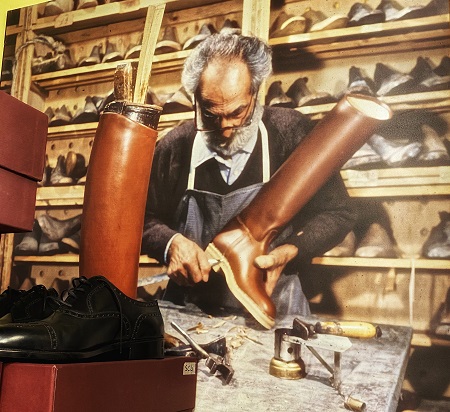
Papà Mercurio nel suo laboratorio
Share this activity:
The art of Italian shoe design: Mercurio and Sons
Dal 1932, Martino Mercurio si è occupato di pelle e calzature costruendo nel tempo la ditta Mercurio che ormai da tre generazioni è fornitrice ufficiale degli stivali per i Corazzieri della Repubblica Italiana. |
Since 1932, Martino Mercurio has been involved in leather and footwear, building over time the Mercurio company which for three generations has been the official supplier of boots for the Italian Republic Cuirassiers. |
|---|
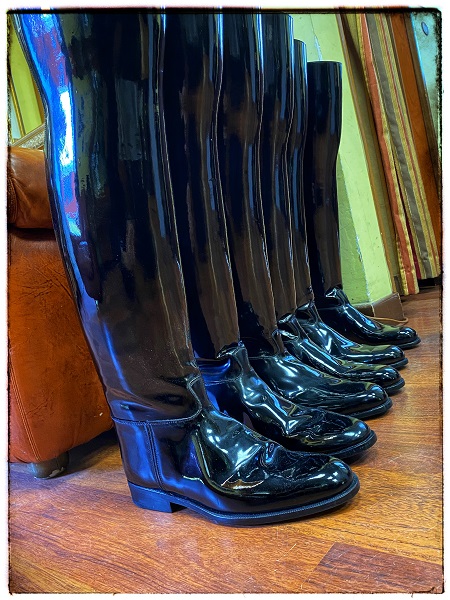
Gli stivali dei Corazzieri Italiani
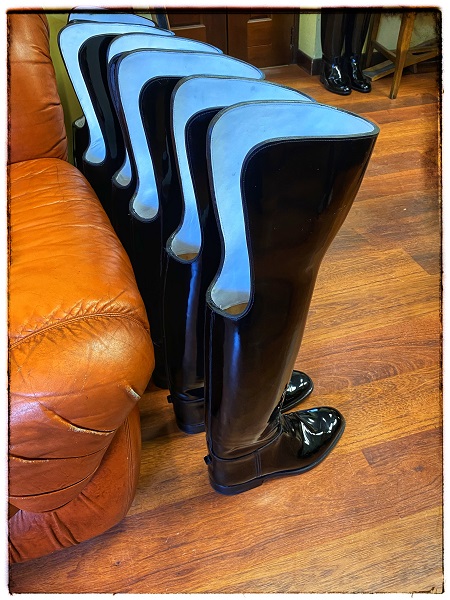
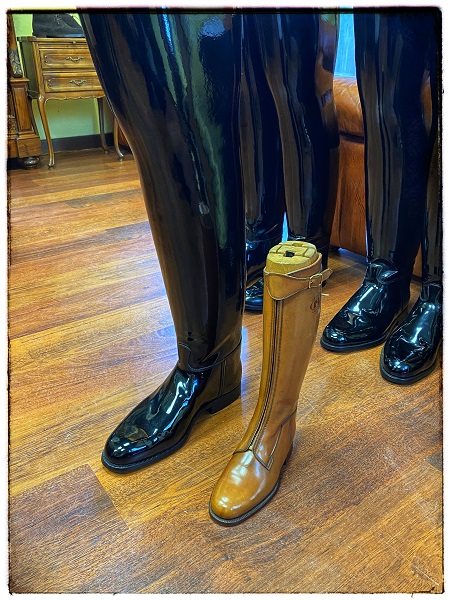
Differenza di misura fra uno stivale da donna
e uno stivale dei Corazzieri Italiani
Il figlio di Martino, Antonio, e il nipote Lorenzo sono gli eredi di una tradizone artigianale e culturale in cui l'estetica italiana è rigorosamente legata alla funzionalità e comodità. |
Martino's son, Antonio, and his nephew Lorenzo are the heirs of an artisan and cultural tradition in which the Italian aesthetic is strictly linked to functionality and comfort. |
|---|
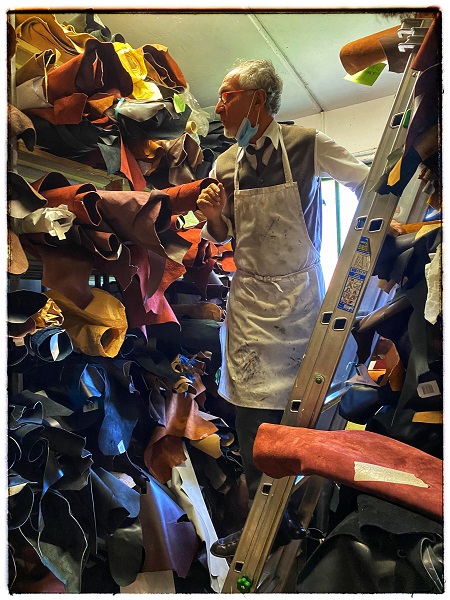
Il Maestro Antonio Mercurio sceglie la pelle più adatta
per il prossimo paio di scarpe da creare
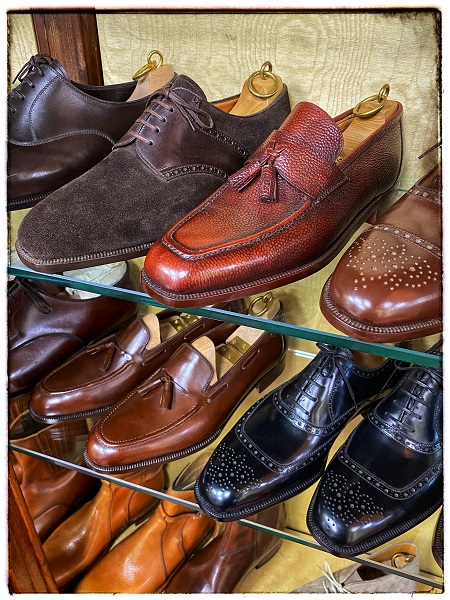
Alcuni modelli da uomo
Abbiamo incontrato il Maestro Antonio Mercurio nel suo laboratorio e gli abbiamo chiesto perché è così importante avere almeno un paio di scarpe artigianali:
"Non esiste al mondo un piede che sia uguale ad un altro". Per questo solo una scarpa fatta a mano può rispettare le caratteristiche anatomiche individuali di ogni piede, con degli accorgimenti che fanno una grande differenza:
1. Con la pelle di qualità il piede è protetto e respira, al contrario di ciò che succede con pelli scadenti o materiali sintetici. Il cuoio della suola permette la completa traspirazione del piede, evitando odori sgradevoli e micosi.
2. La costruzione di una forma individuale in legno prima della realizzare una scarpa è la cosa più importante. Ogni persona ha delle particolarità, se non delle patologie del piede, e delle differenze fra piede destro e sinistro, che, se non vengono prese in considerazione, nel tempo possono creare disagi, problemi di postura o aggravare patologie esistenti. Il piede può anche adattarsi ad una calzatura inadeguata ma alla lunga, per evitare di sentire dolore, si sposta all'interno della scarpa creando storture della postura e in alcuni casi danni irreversibili come dolore alle articolazioni, alluce valgo, distorsione plantare, spina calcagnare. Il piede ha un complesso sistema di recettori propriocettivi (cinestetici) e questi vanno salvaguardati evitando infiammazioni ed eventuali patologie che possano richiedere interventi chirurgici.
3. La struttura della scarpa artigianale, studiata appositamente sulle necessità del singolo, sostiene il piede nelle sue curve naturali e lo aiuta a mantenere la propria fisiologia e funzionalità. |
We met Maestro Antonio Mercurio in his workshop and asked him why it is so important to have at least one pair of handmade shoes:
"There is no foot in the world that is the same as another". For this reason, only a handmade shoe can respect the individual anatomical characteristics of each foot with some expedients that make a big difference:
1. With quality leather the foot is protected and breathes, unlike what happens with poor leather or synthetic materials. The leather of the sole allows the complete transpiration of the foot, avoiding unpleasant odors and mycosis.
2. Building an individual wooden form before making a shoe is the most important thing. Each person has particularities, if not foot pathologies, and differences between right and left foot, which, if not taken into consideration, over time can create discomfort, posture problems or aggravate existing pathologies. The foot can adapt to an inadequate shoe but in the long run - to avoid feeling pain - it will move inside the shoe creating distortions of the posture and in some cases irreversible damage such as pain in the joints, hallux valgus, plantar sprain, heel spurs. The foot has a complex system of proprioceptive (kinesthetic) receptors and these must be safeguarded by avoiding inflammation and any pathologies that may require surgery.
3. The structure of the handmade shoe, specifically designed to meet the needs of the individual, supports the foot in its natural curves and helps it to maintain its physiology and functionality. |
|---|
I segreti del Maestro Mercurio
This video is additional reference material and is not property of CyberItalian.
Should you have any problem viewing it, please
notify us.
Thank you for your patience and collaboration!
Le principali fasi di creazione delle scarpe su misura sono così organizzate:
Facciamo un'ultima domada ad Antonio Mercurio: quanto costa una calzatura artigianale? È un lusso?
Una scarpa artigianale costa perché utilizza materiali di alta qualità e richiede uno studio personalizzato della forma combinata all'estetica. Tuttavia, più che un lusso è un investimento, perché dura nel tempo e può risparmiare dolori e problemi di salute.
Per maggiori informazioni, visita il sito di Mercurio |
The stages of creation of custom-made handmade shoes are the following:
Let's ask Antonio Mercurio one last question: how much does a handmade shoe cost? Is it a luxury?
A handmade shoe costs money because it uses high quality materials and requires a personalized study of the shape combined with aesthetics. However, more than a luxury it is an investment, because it lasts over time and it can save you pain and health problems.
For more information, visit the Mercurio website |
|---|
Realizzazione di una scarpa artigianale nel laboratorio Mercurio
This video is additional reference material and is not property of CyberItalian.
Should you have any problem viewing it, please
notify us.
Thank you for your patience and collaboration!